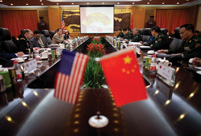 'Jin' named the word of the year by cross-strait netizens
'Jin' named the word of the year by cross-strait netizens Chinese scientific expedition goes to build new Antarctica station
Chinese scientific expedition goes to build new Antarctica station
 Chinese naval escort fleet conducts replenishment in Indian Ocean
Chinese naval escort fleet conducts replenishment in Indian Ocean 17th joint patrol of Mekong River to start
17th joint patrol of Mekong River to start China's moon rover, lander photograph each other
China's moon rover, lander photograph each other Teaming up against polluters
Teaming up against polluters
China's science community moved closer to its goal of a fully integrated system for making high-resolution observations of the Earth's surface from space on Monday, as the first satellite of that system was officially put into operation.
The activation of the Gaofen-1 satellite marks a milestone in a program that will substantially improve the nation's capabilities in disaster relief, surveying and environmental protection, the State Administration of Science, Technology and Industry for National Defense, which oversees the program, said in a statement.
The administration said the satellite is able to obtain high-resolution data over vast swaths of land, noting it will take only four days to map the entire globe.
Gaofen-1 was sent into space aboard a Long March-2D rocket from Jiuquan Satellite Launch Center in Gansu province on April 26. After entering orbit, it underwent eight months of trial operation and tests. Now it's live.
Developed by the China Academy of Space Technology, Gaofen-1 will be followed by another four or five satellites before the end of 2016 to form the high-definition Earth observation system — among China's 16 most important national projects in science and technology.
The satellite is equipped with a 2-meter-resolution, charge-coupled camera, an 8-meter multispectrum imager, and four 16-meter, wide-field multispectrum imagers. The equipment enables the satellite to take a clear picture of a single automobile on the surface.
Major users of the Gaofen-1 are the ministries of land and resources, environmental protection and agriculture. Another 15 central departments also signed agreements allowing them to access satellite information.
"Compared with other remote-sensing satellites, Gaofen-1 has greater capabilities in terms of Earth surveys and can significantly improve our nation's performance in this field,” said Wang Chengwen, deputy commander of the Gaofen-1 project.
By improving the precision and timeliness of data, the satellite could play an important role in disaster relief in a country hit often by earthquakes, floods and other natural calamities.
During its shakedown period after entering orbit, the satellite helped assess the status of deserts in the Aibi Lake area, in the Xinjiang Uygur autonomous region; provided relief workers with high-resolution photos of places affected by the magnitude-6.6 quake that shook Gansu province in July; and recorded the record-breaking floods that hit Heilongjiang province in August, according to Wang.
"Using Gaofen-1, we could obtain information of the flooded areas in a timely and precise manner,” said Yang Guangyuan, deputy director of Heilongjiang provincial bureau of water resources. "It provided pictures with accurate coordinates for each place, and it updated very quickly.”
In addition, at the request of the Asia-Pacific Space Cooperation Organization, the satellite helped Pakistani authorities see areas hit by a magnitude-7.7 earthquake on Sept 24.
The satellite can help improve land-resource surveying, environmental monitoring, geographical and oceanic mapping as well as provide support to precision agriculture.
"With the assistance of satellite surveys, we found that the total area of China's wetlands has decreased by 33 percent over the past 30 years. Next, we will use Gaofen-1 to analyze the reasons for the changes,” Yang said.
The project to set up a high-resolution Earth observation system received government approval and was launched in 2010.
China intends to establish an extremely precise Earth observation system integrated with other measures for a complete observation system that works in all weather at all hours of the day and across the globe.
There are more than 50 countries that own or operate Earth observation satellites, and the data they collect is used for economic and social activities and in scientific research.
 Commemorate 120th birth anniversary of Mao Zedong
Commemorate 120th birth anniversary of Mao Zedong Female soldiers of PLA Marine Corps in training
Female soldiers of PLA Marine Corps in training Chinese cities to have a very grey Christmas as smog persists
Chinese cities to have a very grey Christmas as smog persists China and U.S. - the national image in each other’s eyes
China and U.S. - the national image in each other’s eyes The Liaoning's combat capability tested in sea trial
The Liaoning's combat capability tested in sea trial Chinese pole dancing team show their moves in snow
Chinese pole dancing team show their moves in snow Rime scenery in Mount Huangshan
Rime scenery in Mount Huangshan Ronnie O'Sullivan: My children mean the world to me
Ronnie O'Sullivan: My children mean the world to me Shopping in Hong Kong: a different picture
Shopping in Hong Kong: a different picture The buzzwords in 2013
The buzzwords in 2013 Top 10 domestic news of 2013
Top 10 domestic news of 2013 Red crabs begin annual migrations in Australia
Red crabs begin annual migrations in Australia Artifacts retrieved from West Zhou Dynasty
Artifacts retrieved from West Zhou Dynasty Aftermath of Volgograd railway station blast
Aftermath of Volgograd railway station blast Fleet hits targets in training
Fleet hits targets in trainingDay|Week|Month